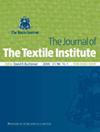利用贝叶斯优化卷积神经网络简化基于视频的自动织物模式识别
IF 1.5
4区 工程技术
Q2 MATERIALS SCIENCE, TEXTILES
引用次数: 0
摘要
摘要织物织型的检测涉及到基于图像的表面纹理特征的获取,而基于图像的表面纹理特征的获取由于织物结构的复杂性而变得困难。随机捕获静态图像可能与织物的整个STF不相关。传统的FWPs分析是通过人的视觉进行的,这导致了大量的认知负荷。最终,人类基于视觉的认知负荷导致质量检测无效和易出错的FWPs分析结果。鉴于上述挑战,本研究提出了一种新的基于精简视频的FWPs识别方法,该方法结合了贝叶斯优化卷积神经网络(Bayes Opt-CNN)。从本质上讲,这种方法能够利用织物复杂表面结构的时空特征。在本研究中,为了验证所提出方法的有效性,将7种类型的织物结构捕获为流线视频,然后将其转换为图像帧序列。随后,引入贝叶斯优化过程,在基于cnn的监督学习模式识别中选择最佳超参数。评价表明,该方法在识别fwp方面优于基准方法。关键词:贝叶斯优化卷积神经网络分类织物模式识别表面纹理特征视频数据披露声明作者未报告潜在利益冲突本文章由计算机程序翻译,如有差异,请以英文原文为准。
Streamline video-based automatic fabric pattern recognition using Bayesian-optimized convolutional neural network
AbstractExamining fabric weave patterns (FWPs) is connected to image-based surface texture feature (STF) acquisition, which can be difficult due to the structural complexity of woven fabrics. Randomly capturing static images may not correlate with the entire STF of a fabric. Traditionally, FWPs analysis is conducted by human vision, which causes an intensive cognitive load. Ultimately, the human vision-based cognitive load leads to ineffective quality inspection and error-prone FWPs analysis results. Given the above challenges, this study proposes a new streamlined video-based FWPs recognition method by incorporating Bayesian-optimized convolutional neural network (Bayes Opt-CNN). Essentially, this method is capable of leveraging the spatiotemporal features of the fabric’s intricate surface structure. In this study, to validate the effectiveness of the proposed method, seven types of fabric structures were captured as streamline videos, which were then converted into sequences of image frames. Subsequently, the Bayesian optimization process was introduced to select the best hyperparameters during CNN-based supervised learning for pattern recognition. The evaluation demonstrates that the proposed method outperforms the benchmark method for identifying FWPs.Keywords: Bayesian optimizationconvolutional neural networksclassificationfabric pattern recognitionsurface texture featuresvideo data Disclosure statementNo potential conflict of interest was reported by the authors.
求助全文
通过发布文献求助,成功后即可免费获取论文全文。
去求助
来源期刊

Journal of the Textile Institute
工程技术-材料科学:纺织
CiteScore
4.20
自引率
5.90%
发文量
149
审稿时长
1.0 months
期刊介绍:
The Journal of The Textile Institute welcomes papers concerning research and innovation, reflecting the professional interests of the Textile Institute in science, engineering, economics, management and design related to the textile industry and the use of fibres in consumer and engineering applications. Papers may encompass anything in the range of textile activities, from fibre production through textile processes and machines, to the design, marketing and use of products. Papers may also report fundamental theoretical or experimental investigations, including materials science topics in nanotechnology and smart materials, practical or commercial industrial studies and may relate to technical, economic, aesthetic, social or historical aspects of textiles and the textile industry.
All published research articles in The Journal of The Textile Institute have undergone rigorous peer review, based on initial editor screening and anonymized refereeing by two expert referees.
 求助内容:
求助内容: 应助结果提醒方式:
应助结果提醒方式:


